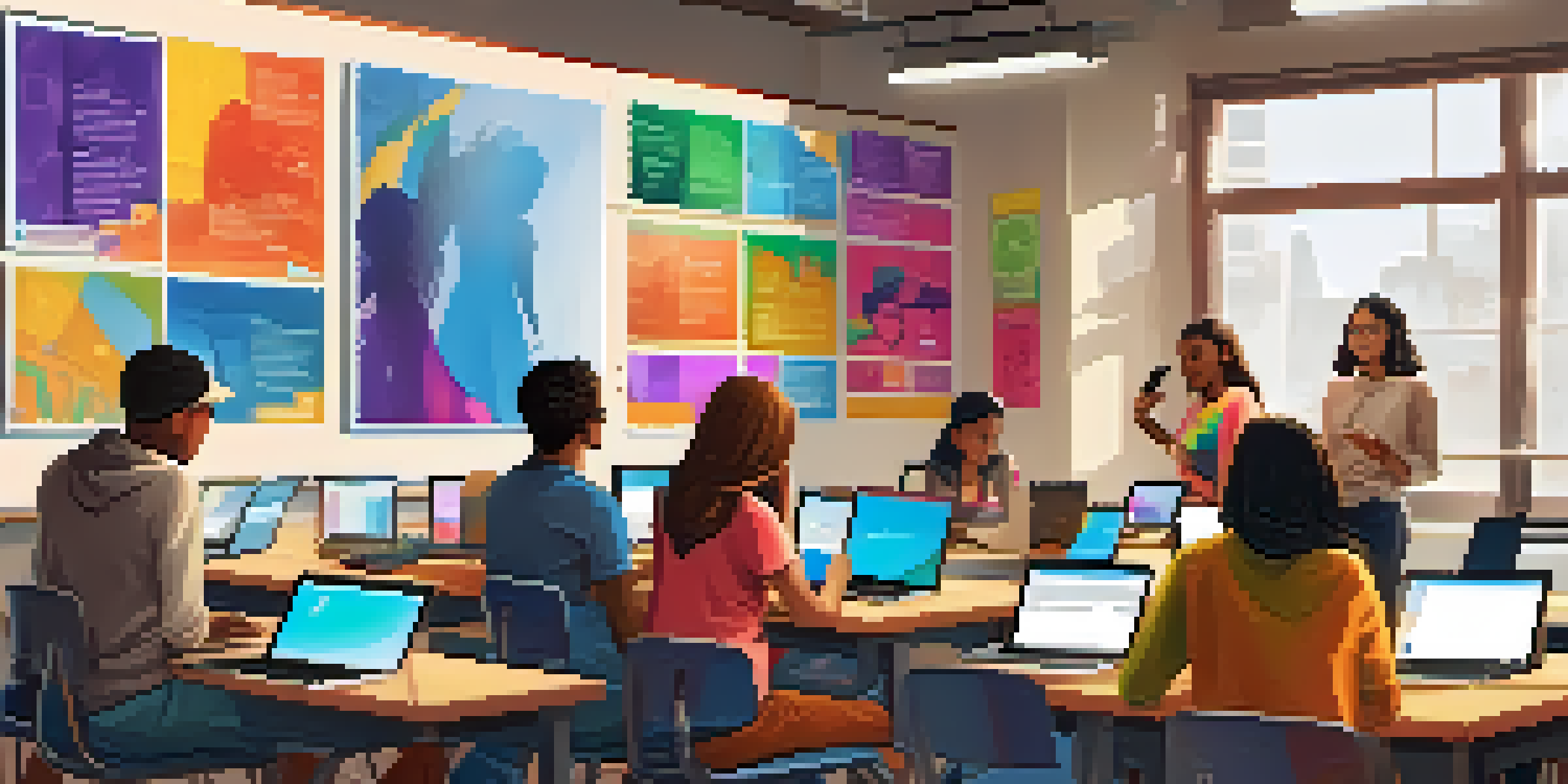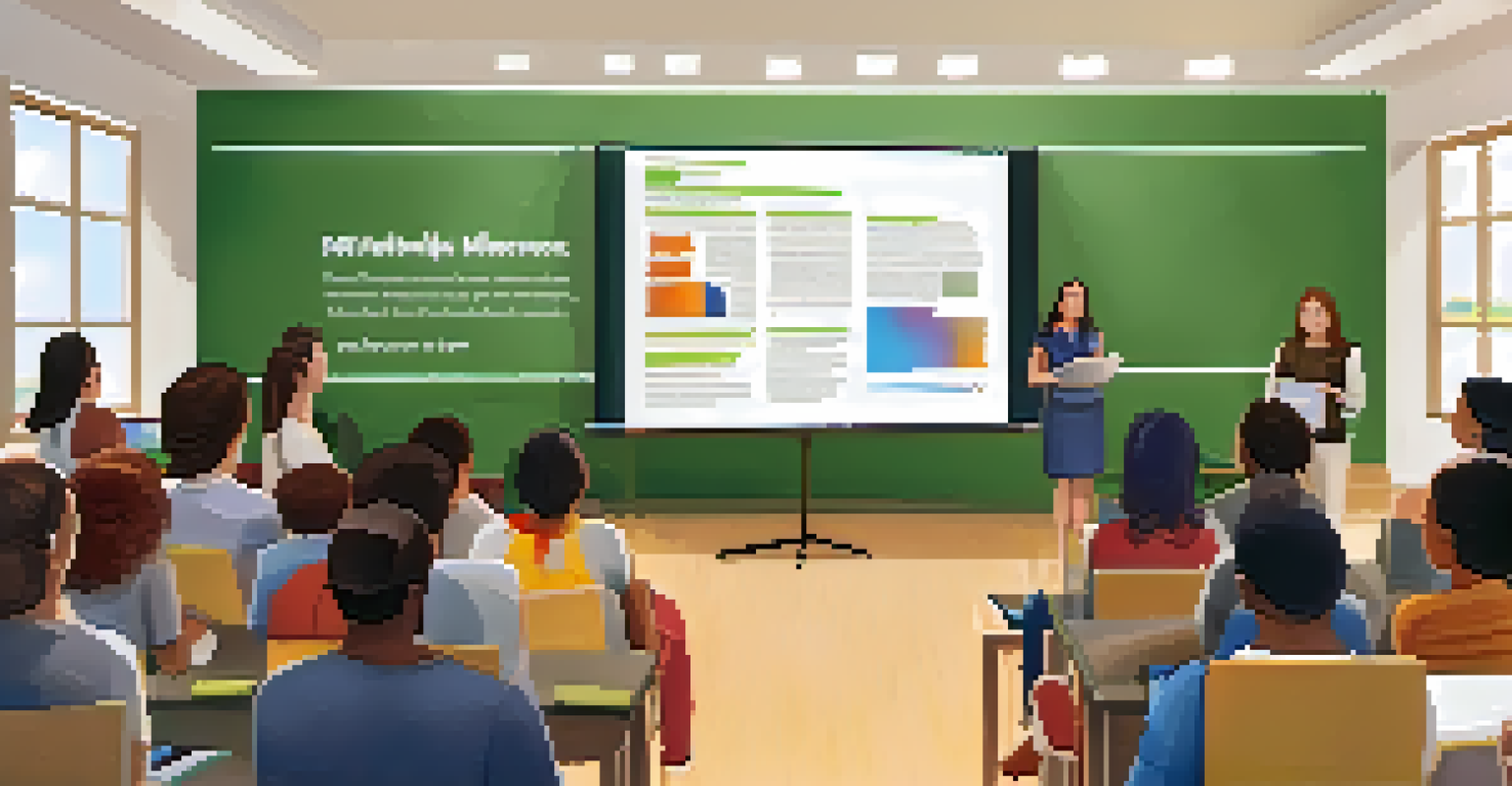How to Encourage Positive Social Media Use in Schools

Understanding the Role of Social Media in Education
Social media is more than just a platform for sharing photos and updates; it can be a powerful educational tool. Educators are increasingly recognizing how social media can foster collaboration, creativity, and communication among students. By integrating these platforms into the learning process, schools can create a dynamic environment that encourages student engagement.
Social media is not just a tool for communication; it is a tool for learning and collaboration.
However, it's essential to approach social media use thoughtfully. While it offers many benefits, there are also risks involved, such as cyberbullying and misinformation. By understanding both sides, educators can better guide students in navigating the digital landscape.
Ultimately, the goal is to harness social media's potential while minimizing its pitfalls. This balance can lead to a more enriching educational experience, preparing students not just academically but also socially.
Setting Clear Social Media Guidelines for Students
Establishing clear social media guidelines is crucial for promoting positive usage among students. These guidelines should cover appropriate behavior, privacy settings, and respectful communication. When students know what is expected of them, they are more likely to engage responsibly online.

Involving students in the creation of these guidelines can increase their buy-in and commitment. By discussing the dos and don’ts collaboratively, students will feel a sense of ownership and responsibility over their online actions. This approach also opens up an avenue for discussions about the consequences of negative behavior.
Social Media as an Educational Tool
Educators can use social media to foster collaboration, creativity, and communication among students.
Regularly revisiting and updating these guidelines ensures they remain relevant in an ever-evolving digital landscape. When students feel confident about their social media use, they can explore its benefits while steering clear of potential dangers.
Promoting Digital Citizenship and Responsibility
Digital citizenship is about teaching students how to use technology responsibly and ethically. Schools should incorporate digital citizenship lessons into their curriculum, addressing topics like online etiquette, privacy, and the impact of their digital footprint. This education empowers students to make informed decisions online.
The internet is a great way to get on the net.
Real-life scenarios and role-playing exercises can illustrate the importance of digital responsibility. For example, discussing situations involving cyberbullying can help students understand the emotional impact of their online actions. By learning to empathize with others, students are more likely to treat their peers with respect.
Encouraging students to be proactive in their online interactions fosters a culture of kindness and support. When students recognize their role as positive contributors to the digital community, they are more likely to engage in constructive behavior.
Incorporating Social Media into Classroom Activities
Integrating social media into classroom activities can enrich the learning experience. For instance, teachers might use platforms like Twitter for literature discussions or Instagram for showcasing student projects. This not only makes learning more interactive but also familiarizes students with the educational potential of social media.
Teachers can create assignments that encourage students to explore social media's resources, such as following educational accounts or joining relevant groups. This exposure can enhance their understanding of various subjects while developing their critical thinking skills.
Importance of Clear Guidelines
Establishing clear social media guidelines helps students engage responsibly and fosters a sense of ownership.
When students see social media as a tool for learning rather than just socializing, they become more engaged and purposeful in their online activities. This shift can lead to deeper discussions and a more profound appreciation for the content being studied.
Encouraging Parental Involvement in Social Media Education
Parents play a vital role in shaping their children's social media habits. Schools should actively involve parents in discussions about social media use, offering workshops or informational sessions to educate them on the digital landscape. This partnership can create a supportive network that reinforces positive online behavior.
By sharing resources and strategies with parents, schools can empower families to engage in conversations about social media at home. Encouraging parents to model positive online behavior can also make a significant impact on students' actions.
When parents and educators work together, they can create a consistent message about responsible social media use. This collaboration can lead to healthier online habits for students and a stronger community overall.
Recognizing and Addressing Negative Social Media Behaviors
It's essential for schools to recognize signs of negative social media behavior, such as cyberbullying or excessive screen time. Educators should be trained to identify these issues early and respond appropriately. Open channels of communication can encourage students to report their concerns without fear of judgment.
Schools can implement support systems, such as counseling services or peer support groups, to help students navigate these challenges. Providing resources and a safe space for discussions can empower students to seek help when needed.
Promoting Digital Citizenship
Teaching digital citizenship empowers students to use technology responsibly and ethically, enhancing their online interactions.
Addressing negative behaviors promptly helps maintain a positive school culture. By creating an environment where everyone feels safe and supported, students can thrive both online and offline.
Celebrating Positive Social Media Contributions
Recognizing and celebrating positive contributions on social media can motivate students to engage responsibly. Schools can create initiatives that highlight students' achievements, such as showcasing creative projects or positive community interactions online. This recognition fosters a sense of pride and encourages others to follow suit.
Incorporating awards or shout-outs on school platforms can amplify this effect. For instance, a 'Social Media Star of the Month' recognition can inspire students to contribute positively while reinforcing the values the school stands for.

When students see that their positive actions are valued, they are more likely to continue engaging thoughtfully on social media. This celebration of positivity can create a ripple effect, inspiring a culture of kindness and respect.
Evaluating the Impact of Social Media Use in Schools
Regularly evaluating the impact of social media initiatives in schools is vital for continuous improvement. Educators should gather feedback from students, parents, and staff to assess the effectiveness of their programs. This feedback can help identify areas for growth and ensure that strategies remain relevant.
Surveys or focus groups can provide valuable insights into students' experiences with social media in the educational context. Understanding what works and what doesn't helps schools adapt their approaches to better meet the needs of their community.
Being open to change and willing to innovate can lead to a more effective integration of social media in education. By taking the time to evaluate and adjust, schools can foster a positive environment that supports healthy social media use.